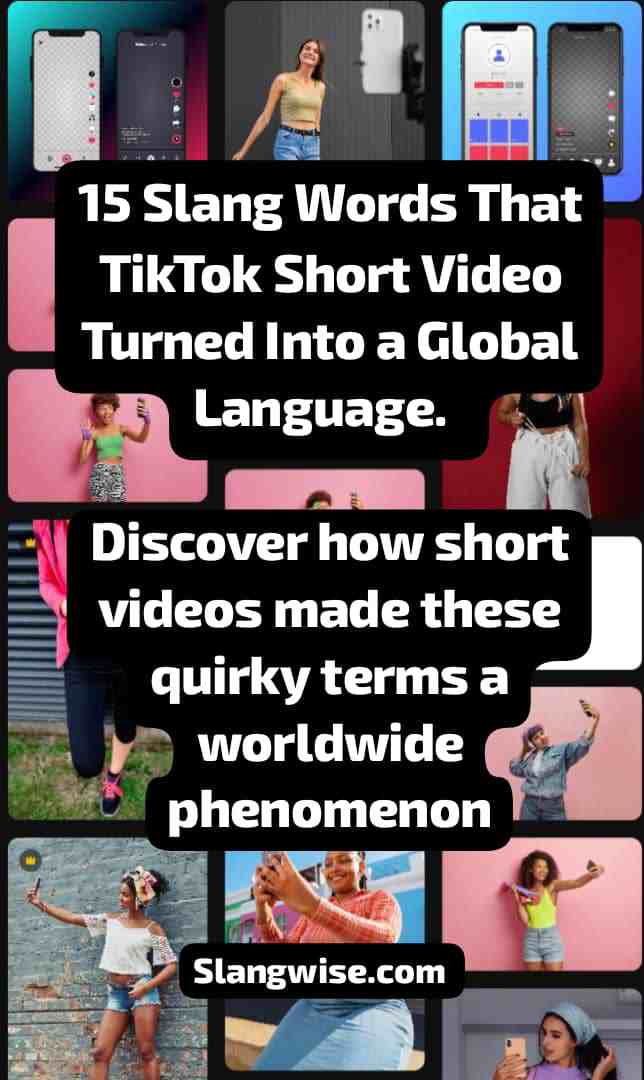I still get a little thrill when a two-second clip teaches me a word I didn’t know yesterday and everyone’s using today. TikTok didn’t invent slang, language has always been playful and fast, but those short, looping videos turned private jokes and niche phrases into global habits almost overnight.
In a platform where sound, gesture, and timing carry meaning, a catchy phrase becomes a meme, a meme becomes a dictionary entry, and suddenly strangers across continents are speaking the same tiny grammar of feeling.
In this piece I’m unpacking 15 slang words that short videos turned into a worldwide language. I’ll show how each term spread (the sound bites, the context, the creators who amplified it) and why these little words matter: they tell us what people are feeling, what culture is paying attention to, and how fast we now borrow one another’s tongues.
Read them with curiosity, and a little caution, because knowing the word doesn’t always mean you should use it in every room.
Table of Contents
In a nutshell
- Short-form power: TikTok’s quick, looping videos turned niche phrases into catchy hooks that stuck in global feeds.
- Viral remix: Creators layered trending words onto dances, challenges, and sounds, cementing them in everyday speech.
- Cultural fusion: A blend of languages, regions, and subcultures on TikTok pushed slang beyond local borders.
- Memetic spread: Engagement via duets, stitches, and shares turned playful words into global memes.
SlangWise Tip: “Listen more than you speak trendy words reveal cultural shifts, and understanding them keeps communication fresh.”
15 Slang Words That TikTok Turned Into a Global Language
1. Drip
Originally hip-hop jargon for stylish attire, drip exploded on TikTok as users flaunted outfits and accessories. The hashtag #DripCheck amassed billions of views, inspiring fashion lovers worldwide to share their best looks. Today, calling someone’s wardrobe “drip” signals admiration for their style.
We asked teens to explain what drip means – their answers will surprise you.
2. Bussin’
Bussin’ describes exceptionally tasty food. Videos of homemade recipes or restaurant reviews tagged #Bussin became instant hits. Its catchy rhythm made it easy to remember and repeat in comments and video captions.
3. Cheugy
Deployed to label outdated or try-hard trends, cheugy gained traction when influencers humorously pointed out millennial fashion and décor faux pas. Its precise poke at a generation’s quirks struck a chord globally.
Psychology of trends discussed on Psychology Today explains why cheugy resonated.
4. No Cap
To assert honesty, users adopted no cap (“no lie”). The assertion spread through testimonials, reaction duets, and comedy skits. As TikTok’s community sought authenticity, this phrase became a badge of truth.
5. FYP
Standing for “For You Page,” FYP became shorthand for content that feels personally tailored. Creators captioned videos “heard this on my FYP” to nod toward trending discoveries, blending platform terminology into everyday talk.
Social media analytics sites like Influencer Marketing Hub dive into FYP dynamics.
6. Skrrt
Imitating the sound of screeching tires, skrrt signals rapid movement or excitement. Users dropped it in dance transitions and humorous voiceovers. The onomatopoeia’s punchy feel made it ideal for short clips.
7. Sksksk
Originating from online fan culture, sksksk became a laughter stand-in or excited gasp. It paired with VSCO girl aesthetics and comedic videos, cementing its place as an expressive, global keyboard jam.
8. Periodt
An extra ‘t’ on period adds emphasis, ending statements with force. TikTok debates, reaction videos, and affirmations often close with periodt, signaling unconditional agreement.
9. Cheems
Meme culture’s Shiba Inu avatar, Cheems, became a character in video edits. Creators wrote humorous scripts around Cheems’ imagined dialogue, giving life to this playful dog and spreading its name worldwide.
Digital culture essays at Know Your Meme detail Cheems’ backstory.
10. Simp
Once an insult for over-the-top admiration, simp transformed on TikTok into playful banter. From song samples to comedic skits, users tagged videos #Simp to mock or admit infatuation.
11. Yeet
A joyful exclamation or to throw something with force, yeet thrived in challenge videos. Whether tossing props or celebrating victories, yeet’s versatility made it a TikTok staple.
12. Goated
To be the Greatest Of All Time, goated appeared in sports highlights, music remixes, and career milestones. From slam dunks to mic drops, goated praised top-tier performances.
13. Cheesy TikTok Sound Effects
While not a single word, TikTok’s library of quirky sound effects (e.g., scream tries, record scratches) functions like slang. Users embed these cues to convey mood, turning sounds into universal signals.
Platform insights on the TikTok Newsroom explain sound trends.
14. Fit Check
Similar to #DripCheck, fit check invites viewers to rate full-body outfits. Fashion influencers and casual stylists used the tag to solicit feedback, making it a cross-border style ritual.
15. Buss It
Based on an R&B beat drop, the #BussItChallenge saw users start casual and end glam. The challenge’s visual “transformation” hook fueled its global fame, embedding “buss it” into challenge culture.
Conclusion
Language moves fast now, and that’s both exciting and messy. Those 15 slangs aren’t just fun labels; they’re evidence of a new kind of cultural speed, ideas packaged for attention, shared with a tap, and turned into common speech before we even notice.
Use them to connect, not to replace real conversation; laugh at how weird they sound when you first say them; and remember that every new slang carries the fingerprints of the communities that made it.

